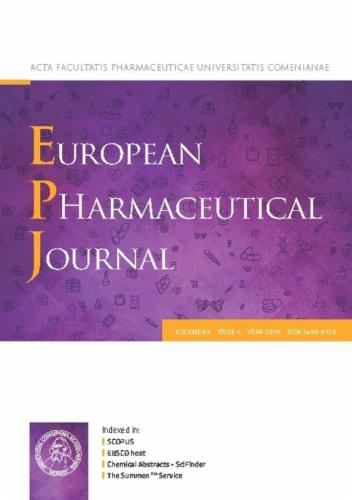Combining chromatographic and spectroscopic fingerprinting with chemometrics and data fusion to characterize the phytochemical composition of anthocyanin-rich fruit extracts
IF 4.3
3区 医学
Q1 PHARMACOLOGY & PHARMACY
引用次数: 0
Abstract
Due to high visual similarity, rich anthocyanin content, drastically different availability, and wide use in the pharmaceutical and food industries, products that contain fruits of the genus Vaccinium can become targets of adulteration. This study aimed to obtain phytochemical fingerprints of two anthocyanin-rich fruit extracts (highbush blueberry and bilberry) using four different analytical techniques (HPLC-UV; HPLC-MS/MS; FTIR; UV/Vis) and explore the relationships and similarities of the chemical compositions by applying chemometric data analysis (PCA and PLS-DA) combined with low-level and mid-level data fusion approaches. Tentative identification with subsequent quantification of polyphenols found in these extracts was performed using HPLC-MS/MS analysis. To test the application of mid-level data fusion combined with chemometrics, mixed extracts containing highbush blueberry as well as bilberry extracts were prepared and analyzed. Highbush blueberry lyophilized extracts contained roughly 5 times more chlorogenic acid than bilberry extracts, while bilberry extract showed higher concentrations of anthocyanins and caffeic acid. Both extracts had highly similar spectroscopic fingerprints. After mid-level data fusion, an optimized PLS-DA model with 75 observations (65 pure extract samples, 10 mixed extract samples) and 7 key variables (first principal components of all analysis) was developed (R2X 0.950, R2Y 0.949, and Q2 0.941). This model allows to correctly classify pure extracts from mixed extracts, but cannot differentiate between different ratios of mixes. Combining fingerprinting information with mid-level data fusion can simplify the model while still accurately representing the key features of phytochemical fingerprints and is worth examining as a tool for the detection of anthocyanin-rich extract adulterations in the future.

结合色谱和光谱指纹图谱、化学计量学和数据融合技术对富含花青素的水果提取物进行植物化学成分表征。
由于视觉相似性高,花青素含量丰富,可得性差异大,在制药和食品工业中广泛使用,含有Vaccinium属果实的产品可能成为掺假的目标。本研究旨在利用四种不同的分析技术(高效液相色谱-紫外光谱;HPLC-MS /女士;红外光谱;通过化学计量数据分析(PCA和PLS-DA),结合中低水平数据融合方法,探索化学成分之间的关系和相似性。采用高效液相色谱-质谱联用(HPLC-MS/MS)方法对提取物中的多酚进行初步鉴定和定量分析。为验证中级数据融合结合化学计量学的应用,制备了含有高丛蓝莓和越橘提取物的混合提取物并进行了分析。高丛蓝莓冻干提取物的绿原酸含量约为越橘提取物的5倍,而越橘提取物的花青素和咖啡酸含量更高。两种提取物的光谱指纹图谱高度相似。经过中级数据融合,建立了包含75个观测值(65个纯提取样本,10个混合提取样本)和7个关键变量(所有分析的第一主成分)的优化PLS-DA模型(R2X 0.950, R2Y 0.949, Q2 0.941)。该模型可以正确区分纯提取物和混合提取物,但不能区分不同比例的混合物。将指纹信息与中级数据融合相结合,可以简化模型,同时仍能准确地反映植物化学指纹的关键特征,作为未来检测富含花青素提取物掺假的工具值得研究。
本文章由计算机程序翻译,如有差异,请以英文原文为准。
求助全文
约1分钟内获得全文
求助全文
来源期刊
CiteScore
9.60
自引率
2.20%
发文量
248
审稿时长
50 days
期刊介绍:
The journal publishes research articles, review articles and scientific commentaries on all aspects of the pharmaceutical sciences with emphasis on conceptual novelty and scientific quality. The Editors welcome articles in this multidisciplinary field, with a focus on topics relevant for drug discovery and development.
More specifically, the Journal publishes reports on medicinal chemistry, pharmacology, drug absorption and metabolism, pharmacokinetics and pharmacodynamics, pharmaceutical and biomedical analysis, drug delivery (including gene delivery), drug targeting, pharmaceutical technology, pharmaceutical biotechnology and clinical drug evaluation. The journal will typically not give priority to manuscripts focusing primarily on organic synthesis, natural products, adaptation of analytical approaches, or discussions pertaining to drug policy making.
Scientific commentaries and review articles are generally by invitation only or by consent of the Editors. Proceedings of scientific meetings may be published as special issues or supplements to the Journal.

 求助内容:
求助内容: 应助结果提醒方式:
应助结果提醒方式:


